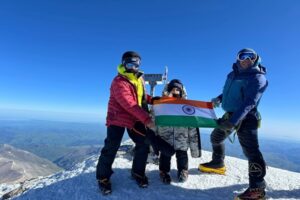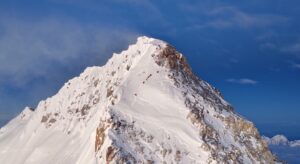Everyone in Everest Base Camp keeps quiet about the COVID outbreak, while high above, the Sherpa rope-fixing team is just one good day from the summit.
Kami Rita and the Everest Fixers sounds like a rock band. They are certainly rocking on Everest right now. With lead man Kami Rita Sherpa, these first-class Sherpa climbers are the only ones doing Everest without ropes. That’s because they are the guys setting the ropes. A difficult job, especially this very dry year.

The route up Everest from Camp 2, including “lower” Camp 3. Photo: Paul Pottinger
Despite snow yesterday in Base Camp, a significant number of climbers have decided to spend several days in Camp 2. This includes Colin O’Brady, who set off with Dawa Sherpa today for Camp 2, bypassing the usual night in Camp 1. He won’t return to BC before next week.
Money talks
Meanwhile, Nepal authorities continue to deny/avoid discussing the COVID outbreak. The Department of Tourism continues granting Everest permits: From an already record 394 on April 27, it rose to 408 on April 28. At $11,000 per permit, Nepal has already earned close to $4.5 million from those alone.
At the same time, authorities have imposed a two-week lockdown in Kathmandu, Pokhara, and other areas with high contagion rates. They also reestablished a 10-day quarantine for everyone entering the country.
As usual, confusion surrounds certain of the new regulations. Since road transport is banned for the next two weeks, except for essential services, climbers and trekkers returning from the mountains may have trouble returning to Kathmandu. The Kathmandu Post published some useful information about this earlier today.
Kathmandu sources also report that the Department of Tourism refuses to take calls from the media and insists that tourism officials, expedition operators, Base Camp staff, and climbers (except those already infected) hide the truth.

Everest Base Camp. Photo: Pascal Denoel
Nepal’s worst-kept secret
This half-secrecy — word does get out — is not only useless, it’s harmful. Travelers about to leave for Nepal aren’t sure what to do. Those in Base Camp behave as if nothing has happened, but they face increasing criticism on social media, for selfishness, and for ignoring safety measures. Some have even accused climbers of bringing the virus into the country.
Yet most Everest hopefuls felt safe, thanks to their double negative PCR test. Some may be vaccinated, but in a number of countries, including all those in the European Union, vaccines are not available privately but only through strict protocols. With the virus already established in Base Camp, teams are now trying to avoid contact beyond their social bubbles. But the harm is already done.





